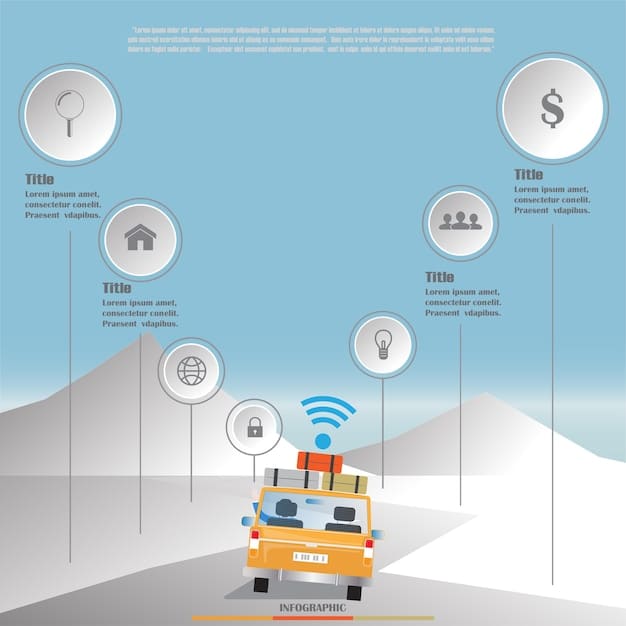Decoding Level 3 Autonomous Driving: A Guide for US Drivers

Decoding Autonomous Driving Levels: What Does Level 3 Really Mean for US Drivers? Level 3 represents “conditional automation,” where the car handles most driving tasks, but a human driver must be ready to intervene when prompted.
Decoding Autonomous Driving Levels: What Does Level 3 Really Mean for US Drivers? As self-driving technology advances, understanding the different levels of automation is crucial, especially Level 3, which brings new capabilities and responsibilities for drivers in the US.
Understanding the Levels of Autonomous Driving
Autonomous driving isn’t an all-or-nothing affair. It’s a spectrum, defined by six levels ranging from 0 (no automation) to 5 (full automation). Understanding these levels is key to understanding what self-driving cars can and can’t do.
Each level represents a different degree of autonomy, with increasing levels of responsibility shifting from the driver to the vehicle. Level 3 is a pivotal point, as it marks the transition from driver assistance to conditional automation.

Defining the Six Levels
The Society of Automotive Engineers (SAE) developed the widely accepted standard for defining driving automation levels. Here’s a brief overview:
- Level 0 (No Automation): The driver controls everything. There may be warning or intervention systems, but the driver performs all driving tasks.
- Level 1 (Driver Assistance): The car provides assistance with either steering or acceleration/deceleration (e.g., adaptive cruise control or lane keeping assist).
- Level 2 (Partial Automation): The car can control both steering and acceleration/deceleration in certain situations. The driver must remain attentive and ready to take control at any time.
- Level 3 (Conditional Automation): The car can perform all driving tasks in limited situations. The driver does not need to constantly monitor the road but must be ready to intervene when prompted.
- Level 4 (High Automation): The car can perform all driving tasks in most situations, even if the driver does not respond to a request to intervene. However, it may be limited to specific geographic areas or conditions.
- Level 5 (Full Automation): The car can perform all driving tasks in all situations. No human driver is required.
Understanding these levels helps to temper expectations and promotes responsible use of advanced driving technologies.
In summary, the levels of autonomous driving provide a clear framework for the progression of self-driving technology, with Level 3 representing a notable shift in responsibility from the driver to the vehicle under specific conditions.
What Makes Level 3 Different?
Level 3 autonomous driving is often considered a “sweet spot” in automation, but it also introduces unique challenges. It requires a delicate balance between automation and human oversight.
The key differentiator for Level 3 is the “conditional” aspect. The car can handle most driving tasks but requires the driver to be ready to take over when the system encounters situations it cannot handle.
The “Human-in-the-Loop” Challenge
One of the biggest challenges with Level 3 is the “human-in-the-loop” problem. It’s difficult for a driver who has been disengaged to quickly regain situational awareness and take control of the vehicle safely.
This challenge has led some automakers to skip Level 3 altogether and focus on Level 4, where the car can handle a wider range of situations without requiring immediate driver intervention.
- Driver Monitoring: Level 3 systems often incorporate driver monitoring systems to ensure the driver is alert and ready to take over.
- Transition Time: The amount of time the driver has to take over is crucial. Systems need to provide adequate warning and a smooth transition.
- Situational Awareness: Maintaining situational awareness after being disengaged is a significant cognitive challenge for drivers.
The human-in-the-loop challenges makes Level 3 a complex and potentially dangerous area of autonomous driving development.
Ultimately, Level 3 distinguishes itself through conditional automation, creating specific challenges related to human intervention and system reliability, prompting nuanced debates about its safety and feasibility.
The Current State of Level 3 in the US
While Level 3 technology exists, its implementation in the US has been slow and cautious. Regulatory hurdles and safety concerns have limited its widespread adoption.
Currently, only a few automakers have deployed Level 3 systems in select vehicles, and even then, the use is often restricted to specific geographic areas and driving conditions.
Regulatory Landscape
The regulatory landscape for autonomous driving in the US is complex and varies from state to state. This patchwork of regulations creates challenges for automakers seeking to deploy Level 3 systems nationwide.
Some states have embraced autonomous driving, while others are more cautious. Federal regulations are still evolving, and there is ongoing debate about how to best regulate this technology.
- State Laws: Individual states have different laws regarding autonomous vehicle testing and deployment.
- Federal Guidelines: The National Highway Traffic Safety Administration (NHTSA) provides federal guidelines for autonomous vehicles, but these are not legally binding.
- Liability: Determining liability in the event of an accident involving a Level 3 vehicle is a complex legal issue.
The regulatory landscape in the US is still evolving, with safety and liability debates continuing to shape the future of autonomous driving.
In essence, the progress of Level 3 deployment in the United States is constrained by varying state regulations and ongoing federal discussions, emphasizing the necessity for clear and cohesive standards.

Benefits and Drawbacks of Level 3 Automation
Level 3 automation offers potential benefits, such as reduced driver fatigue and increased traffic efficiency. However, it also comes with drawbacks, including the risk of driver inattentiveness and the challenge of smooth transitions between automated and manual driving.
Weighing these pros and cons is crucial for consumers and policymakers as they consider the future of autonomous driving.
Potential Advantages
Level 3 automation could potentially improve traffic flow and reduce accidents caused by human error.
By automating mundane and repetitive driving tasks, Level 3 can reduce driver fatigue and allow drivers to focus on other activities while the car is driving itself (within defined limitations).
- Reduced Fatigue: Automating driving tasks can reduce driver fatigue, especially on long trips.
- Increased Efficiency: Level 3 systems can optimize speed and spacing to improve traffic flow.
- Enhanced Safety: Potentially reduces accidents caused by human error.
The potential advantages of Level 3 autonomous driving are compelling, hinting at safer and more efficient transportation systems with reduced driver burden.
Potential Disadvantages
One of the main drawbacks of Level 3 is the challenge of maintaining driver attention and readiness to take over when prompted.
If the driver is not paying attention or is slow to react, it could lead to accidents. The reliance on automation could also lead to a decline in driving skills over time.
- Driver Inattentiveness: The reduced need to actively drive may cause drivers to become inattentive.
- Transition Issues: Smooth and safe transitions between automated and manual driving are crucial but can be challenging.
- Skill Degradation: Over-reliance on automation may lead to a decline in driving skills.
The primary drawbacks of Level 3 autonomous driving center on the challenges of ensuring drivers remain vigilant and capable of regaining control safely, which leads to questions about overall safety.
The Future of Level 3 and Beyond
The future of Level 3 autonomous driving is uncertain, but it will likely play a role in the ongoing evolution of self-driving technology. It might serve as a stepping stone to higher levels of automation.
As technology improves and regulations become clearer, we may see wider adoption of Level 3 systems in the US, or perhaps a shift towards Level 4 and Level 5 automation.
Technological Advancements
Continued advancements in sensor technology, artificial intelligence, and machine learning are crucial for improving the safety and reliability of Level 3 systems.
Better sensors will allow cars to perceive their surroundings more accurately, while improved AI and machine learning algorithms will enable them to make better decisions in complex driving situations.
- Improved Sensors: More advanced sensors (e.g., lidar, radar, cameras) will provide better situational awareness.
- AI and Machine Learning: Improved algorithms will enable cars to make better decisions.
- Connectivity: Vehicle-to-vehicle (V2V) and vehicle-to-infrastructure (V2I) communication will enhance safety and efficiency.
Technological advancements are anticipated to bolster the proficiency of Level 3 systems.
To summarize, the overall evolution of autonomous driving technology hinges on significant improvements in sensory apparatus, artificial intelligence, and interconnected technologies; these developments are closely followed as benchmarks of future progress.
What This Means for US Drivers
For US drivers, the arrival of Level 3 autonomous driving means new opportunities and new responsibilities. It’s important to understand the limitations of the technology and to remain vigilant while using it.
Drivers need to be aware of the laws and regulations in their state and to follow the manufacturer’s instructions for using Level 3 systems safely.
Preparing for the Future
As autonomous driving technology becomes more prevalent, drivers will need to adapt and learn new skills.
This includes understanding how to interact with autonomous systems, knowing when to intervene, and staying informed about the latest developments in the field.
- Education: Drivers need to be educated about the capabilities and limitations of autonomous systems.
- Training: Hands-on training can help drivers learn how to use Level 3 systems safely.
- Adaptation: Drivers need to adapt to the changing role of the driver in an autonomous vehicle.
Adjustments to educational frameworks will enable US drivers to operate alongside autonomous vehicles safely.
Ultimately, integrating autonomous driving technologies into the daily lives of US drivers requires education and awareness, ensuring that individuals can effectively use these systems.
| Key Point | Brief Description |
|---|---|
| 🚦 Level 3 Definition | Conditional automation: Driver must be ready to intervene. |
| ⚠️ Human-in-Loop | Challenges of driver re-engagement and situational awareness. |
| ⚖️ Regulatory Hurdles | Varying state laws and evolving federal guidelines. |
| 🚀 Future Tech | Advancements in sensors, AI, and connectivity are crucial. |
Frequently Asked Questions
▼
Level 2 requires the driver to constantly monitor the driving environment, while Level 3 allows the driver to disengage in certain conditions but must be ready to take over when prompted.
▼
No, the legality of Level 3 vehicles varies by state. Some states have regulations in place, while others do not. Always check local laws before operating a Level 3 vehicle.
▼
Liability in accidents involving Level 3 cars is a complex legal issue. It often depends on whether the driver was properly attentive and whether the system malfunctioned.
▼
Level 3 cars use driver monitoring systems, such as cameras and sensors, to track the driver’s attention level. They provide warnings and alerts if the driver appears inattentive.
▼
Level 3 can reduce driver fatigue on long trips, improve traffic flow in certain situations, and potentially reduce accidents by automating repetitive tasks. However, drivers must stay alert.
Conclusion
Level 3 autonomous driving represents an important step towards full automation, but it also presents unique challenges and responsibilities for US drivers. By understanding the capabilities and limitations of Level 3 systems, and by staying informed about the latest developments in the field, drivers can prepare for the future of autonomous driving and use this technology safely and effectively.





